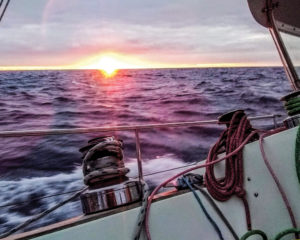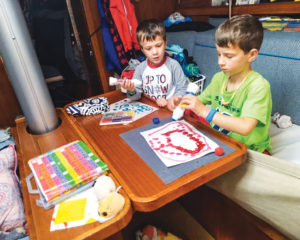This article was originally published in the August 2021 issue of 48° North.
 The triangles on the cold front symbol remind me of teeth — fangs, actually — while I stare at a weather map on my computer screen. Sailing southbound from Alaska to San Francisco, we’re over 100 miles off the Washington coast and are about to get chewed on by the edge of the front. Confirming what I’m seeing, I get a message from a friend on our inReach that reads, “Looks like you’re going to get overtaken by the southern boundary of the low. Winds could reach 40 knots and seas will be 10 to 15 feet, but it won’t last too long. Good luck.”
The triangles on the cold front symbol remind me of teeth — fangs, actually — while I stare at a weather map on my computer screen. Sailing southbound from Alaska to San Francisco, we’re over 100 miles off the Washington coast and are about to get chewed on by the edge of the front. Confirming what I’m seeing, I get a message from a friend on our inReach that reads, “Looks like you’re going to get overtaken by the southern boundary of the low. Winds could reach 40 knots and seas will be 10 to 15 feet, but it won’t last too long. Good luck.”
With the weather assessment complete, I note the time on the top corner of my computer — noon — and start thinking forward. I’m fully aware that we’re in for a difficult 24 hours and we need to prepare. Before departing Alaska, I knew there was a good chance we’d skirt this low and I had time to think through what we needed to do. I close my computer and immediately begin talking through the situation with Jill. The two of us have sailed in similar storm conditions at sea before, which makes the preparation a familiar motion. It’s go time.
THE SETUP
After reaching and running under full canvas for the previous few days, we need to get ready to make the sails small, clean up the cabin, and feed the crew. Yahtzee, our Grand Soleil 39, has a removable inner forestay that we set up for longer passages, so first on the list is to get our small staysail out and rigged on the stay. This job is always best done before the weather hits, and I push it on deck, snap on the hanks, and run the sheets. Before lashing it down, I doublecheck the shackles, lines, and the deck fitting to ensure we won’t have any issues when it’s time for it to fly. While on the foredeck, I also inspect the tie-downs for the dinghy and jerry jugs, and make sure the jack lines are clear.
Now that the staysail and foredeck are ready, I check the reefing lines on the mainsail and get out short lengths of line that can be used for lashings. Down below, Jill prepares a couple meals that we can all eat easily and so we don’t have to cook when the seas get rough. When that’s done, anything that can move in the main cabin is stowed or lashed, and the nav desk gets tidied up. While finishing these tasks, as expected, the northwesterly wind dies, then switches to the southeast. That’s it, the edge of the cold front is here.
Sailing closehauled now, we wait for the wind to start picking up. Like clockwork, by late afternoon it has gone south and risen to 15 knots, then 20 with gusts hitting 30. With the increase in the wind, we hoist the staysail, roll up the genoa completely, and go from one reef in the mainsail then two while plunging onward into rising seas. It’s going to be a rough night.
KEEP MOVING
Slogging our way south, the seas build fast and green water washes over the deck. From underneath Yahtzee’s hard dodger, I alternate between watching the procession of frothing waves and the trim of the sails, periodically peering down below to check on the crew. As always, Jill, Porter, and Magnus are making the best of the situation: reading, listening to music, napping, and playing when possible.
It’s an uncomfortable ride, but we’re safe and making way. Throughout the afternoon and into the evening, I tell myself we just need to keep moving forward and the front will soon pass over us. Then, like a big road sign saying “Go this way!”, I see a line of clouds on the western horizon. That’s what we’ve been waiting for! Instead of continuing southeast and letting it overrun us, I decide to tack and go into it, which will get us out of the other side and into better weather sooner.
Accordingly, we make the only tack on what will end up being a 1,300-mile passage. After settling in on a southwest heading, the sun sets, darkness comes quickly and with it so does cloud cover, driving rain, and even more wind. Gusting in the low 40s now, the gale is fully upon us and we decide to completely strike the mainsail. With the autopilot and Hydrovane working in tandem to keep us on course, I go forward to pull down the sail and Jill eases lines. All the while, waves break over the boat and we can feel exhaustion setting in.
sun sets, darkness comes quickly and with it so does cloud cover, driving rain, and even more wind. Gusting in the low 40s now, the gale is fully upon us and we decide to completely strike the mainsail. With the autopilot and Hydrovane working in tandem to keep us on course, I go forward to pull down the sail and Jill eases lines. All the while, waves break over the boat and we can feel exhaustion setting in.
It’s getting increasingly difficult to sleep while the boat thrashes in the tempest, and when I’m off watch, I mostly stare up through the main hatch knowing that we’re getting through the worst of it. I also think about Jill sitting under the dodger trying to stay out of the rain and wind and, even though I know she can handle the situation, I remain ready to help in an instant.
Finally, at 3 a.m. the powerful southerly starts to abate and, shortly after, the wind switches to a moderate westerly. I breathe a long sigh of relief, we’ve made it out the other side and we can soon settle back in on a downwind heading towards San Francisco. If only it were that easy…
PARK THE BOAT
Though the wind has shifted to a more favorable westerly, it is now blowing only 5 knots and Yahtzee heaves and rolls in the sloppy sea state. With just the staysail up, we need more canvas to gain boatspeed and power us through the ugly swells. Sailing closehauled in such strong wind and waves for over 12 hours has taken a toll on our bodies. We’re fatigued, and it saps our energy further to get the staysail down, the mainsail up, and the genoa rolled out.
Times of exhaustion such as these are when a situation can go from bad to worse and, when I get us going on a new course, it does. When I engage the autopilot, it can’t hold a heading. Well, damn. I set the Hydrovane, but in the lack of wind and still boisterous seas, it has a hard time reliably holding a course, too. Hand steering is the only option.
Sitting behind the helm, I do my best to keep my eyes open in the pouring rain and think, “We’re not trying to be heroes out here, we need to take a break.” Jill and I work through our options and decide that heaving-to will calm the motion of the boat and allow us to stay dry and warm down below, alternate sleeping, and get some much needed nourishment.
With sunrise an hour away, I backwind the genoa to starboard, ease the main, and slow Yahtzee to a near stop. When we start to slide downwind with the waves, I lock the helm and trim the main back in. Balanced now, the motion is significantly better and we’re slowly making way southeast towards San Francisco at about a knot to a knot-and-a-half. Perfect.
THE FIX
For the next six hours, the boys sleep soundly in their bunks and Jill and I trade off sleeping and keeping watch. It is the break we needed, and in that time a moderate west-northwest breeze clears the rain; sunshine and blues skies follow soon after. Feeling refreshed, I get us back on course and set about trying to fix the autopilot while the Hydrovane — which we’ve named ‘Cosmo’ — diligently steers us south.
 Looking at the manual, I go through the troubleshooting guide over and over and can’t come up with a solution. Every time I engage the pilot, it starts to steer the course before the boat rounds up and it kicks off. Perplexed, and with plenty of time on my hands, I start emptying the two stern lazarettes that will grant me access to the steering quadrant. When I finally get to the autopilot arm that attaches to the rudder post, I engage the autopilot again and watch what happens. Aha! When the autopilot tries to steer, the collar that attaches to the rudder post just turns without moving the post. It must have come loose while we were fighting the gale.
Looking at the manual, I go through the troubleshooting guide over and over and can’t come up with a solution. Every time I engage the pilot, it starts to steer the course before the boat rounds up and it kicks off. Perplexed, and with plenty of time on my hands, I start emptying the two stern lazarettes that will grant me access to the steering quadrant. When I finally get to the autopilot arm that attaches to the rudder post, I engage the autopilot again and watch what happens. Aha! When the autopilot tries to steer, the collar that attaches to the rudder post just turns without moving the post. It must have come loose while we were fighting the gale.
Doing my best boat yoga poses, I twist and contort myself into a position where I can tighten the bolts on the collar. The trick here is that I need to simultaneously steer the boat with one hand to align the rudder post with the collar, and turn a wrench with the other hand. Sailing fast on a broad reach, I can feel the boat moving through the waves and figure out that the best time to tighten is when we dip down into a trough. Up and down we go and, slowly but surely, I turn each bolt. Sufficiently tight again, I engage the autopilot and sure enough — it works flawlessly.
After stowing all of the gear and boat bits back in the lazarettes, I put Yahtzee on a new course; running downwind wing-and-wing under brilliant sunshine. Jill and the boys emerge from the cabin and we all sit and watch the beautiful blue waves roll in from behind us. Looking at my watch, I read 12:00, and think, “Wow, that was a wild 24 hours. And one heck of a learning experience.”
Editor’s Note: Andy detailed their family’s full passage from Alaska to San Francisco in a January 2020 48° North article titled “One Tack & Two Jibes”. You can also find the online version at 48North.com.
Andy Cross
Andy Cross is the editor of 48° North. After years cruising the Pacific Northwest and Alaska with his family aboard their Grand Soleil 39, Yahtzee, they sailed south and are currently in the Caribbean Sea. You can follow their adventures at SailingYahtzee.com.






